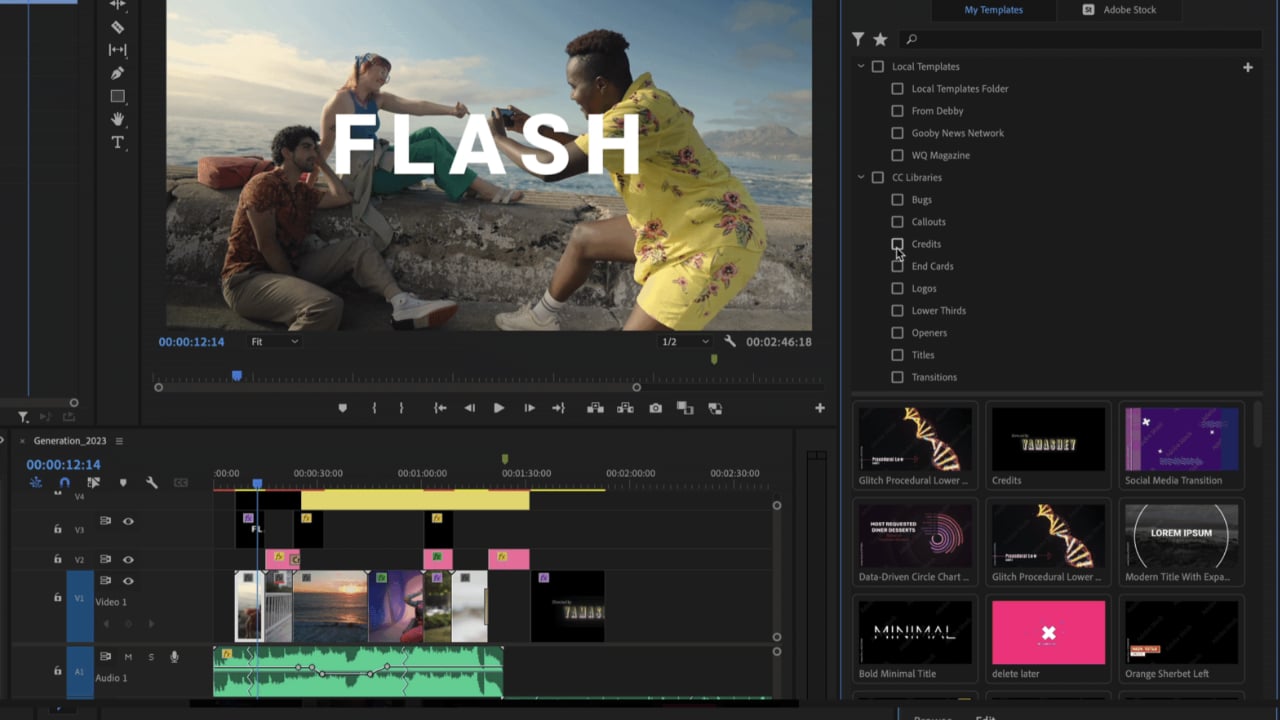
Adobe Premiere Pro 24.1 adds powerful new features and functionalities in its December update.
There’s a fair deal going on in the latest version of Premiere Pro. Text-based editing workflows continue to evolve with Filler Word Detection, while redesigned management of MOGRTs, streamlined sequence presets, easier access to Team Project version history and Auto Save, and other incremental improvements to editing are all included in the latest update. Let’s dive in…
Filler word detection and bulk delete for text-based editing
As well as pauses, text-based editing now lets you detect “uh” and “umm” filler words and bulk delete them so your transcripts are more accurate. Just like with pauses, you can click on a filler word and delete it from your sequence transcript. Filler words are language agnostic, which means they work in all 18 languages supported in Speech to Text.
Pro tip: You can adjust the minimum duration of pauses that Premiere Pro will detect by clicking on the three dots in the top-right corner of the Text panel and selecting Transcript View Options.
Redesigned MOGRT management
Motion Graphics Templates (MOGRTs) give Premiere Pro editors the power of After Effects motion graphics, packaged up as templates with easy-to-use controls designed to be customized in Premiere Pro.
MOGRT management has been made more intuitive. Users can find, view, and organize the MOGRT collections they need across multiple locations, including through folders on disk, with greater ease.
Premiere Pro now displays MOGRTs as individual rows with check marks instead of in a dropdown menu, making it more straightforward to browse a collection across different locations.
There are also now two views to browse MOGRTs. The Browser Tree View displays MOGRT locations, while below the MOGRT view showcases all thumbnail templates from the selected locations. Users have full control of how much space they provide to each view by dragging the window up and down or click on the top funnel button to toggle the Browser Tree View off and on.
New sequence presets
New sequence presets for HD, UHD, HDR, and social media projects are now included. Sequence presets have also been reorganized and streamlined to put the most used selections at editor’s fingertips.
To view the new presets, navigate to File > New Sequence or click the New Item > New Sequence button on the Project panel. This give access to a simplified list of presets, including:
- HD 1080p
- Social for 4x5, 9x16, and 1x1 timelines
- UHD (HDR) for 2160p timelines with an HDR color space
- UHD (4K) for 2160p timelines with an SDR color space
- Legacy for all previously included presets
- Users can edit, delete, or create new presets to streamline their own workflow.
Easier access to Team Projects version history and auto-saves
Access to Team Projects versions and Auto Save history has been unlocked by selecting the Team Project name in the Premiere Pro header bar. The new header bar menu has the following options:
Team Project Settings
Edit the Team Project name, description, collaborators, and other settings such as color, scratch disks, and ingest settings.
Version History
Open the Premiere Pro Media Browser with the version of the Team Project being worked on selected in the saved versions list.
Auto Save History
Open the Premiere Pro Media Browser with the latest auto save of the Team Project selected. Users can create a new Team Project from the auto save or make any version the latest one.
Trimming and multicam improvements
Editors working on feature and episodic workflows will benefit from some incremental improvements to editing and trimming.
Now when creating a new sequence based on a multicam clip, the new sequence will have more predictable audio mapping settings.
A new preference called Ripple trim that adds edits to keep both sides of trim in sync has been added to the Trim preferences under Shift clips that overlap trim points during ripple trimming.
When enabled, Premiere Pro will add edits to clips that overlap a trim. These added edit points will then trim alongside the selected edit points while trimming to prevent any clips from shifting out of alignment on either side of the edit.
Additional updates
There’s more too.
- Support for exporting 16-bit PNG files.
- Destination groupings in Export Mode allow users to toggle sections to hide what they never use to keep the UI tidier.
- Creative Cloud Synced files are being discontinued. Starting February 1, 2024, Adobe will begin to discontinue Creative Cloud Synced files for all free and paid personal users not associated with a Creative Cloud for Enterprise or a Creative Cloud for Teams business account. Read more about the Creative Cloud Files end of life process.
- Sync Settings are being discontinued across Creative Cloud products. Users can migrate custom preset collections from an earlier version of Premiere Pro to another on the same computer.
- System requirements have been updated as of Premiere Pro 24.0 Adobe video and audio products no longer support Rosetta emulation (Intel versions running on Apple M1/M2). Premiere Pro now requires CPU support for AVX2 on x86 AMD and Intel hardware.
Tags: Post & VFX Text-Based Editing


Comments